Fudging This Post
December 22nd, 2009 | 25 Comments
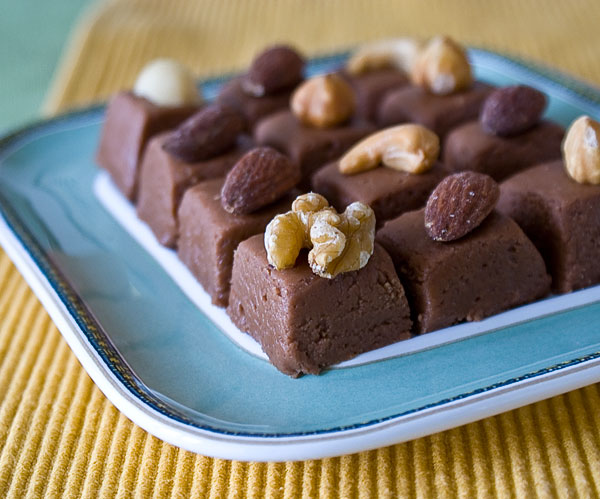
Gluttony. It’s my favorite of the deadly sins and I’m good at partaking in it. And it doesn’t get more rampant than in the month of December. Seems like the second I leave the apartment, I’m offered barrels of cakes and bushels of cookies. Candy to the left of me. Chocolate to the right. I’m like a modern-day Ms. Pac-Man, chomping up everything in my path. And what kind of citizen would I be if I, too, didn’t add to the fattening of my friends and coworkers? Enter: fudge.
Back in the restaurant days of yore, I dressed up the food that came out of my kitchen with some holiday spirit. Each December, some type of fudge made its way on to the petit fours plate. Though I had it in my mind that fudge was supposed to be silky smooth, try as I might, mine usually came out grainy. I’d stand there and scowl at my batch, while my inner-Scrooge barked at the nearest pastry slave to get me more sugar. What I didn’t know at the time was that there was some science to the thing. Now it’s years later and the universe has recently presented me with more evidence that life comes full circle, in the form of this month’s Fine Cooking magazine.
When I turned to page 88, I had one of those adrenaline-fueled heart beats, like when you spot an old ex on Facebook. I saw something familiar, yet mysterious. The feature was about fudge. Specifically, how to get the confounding lot smooth. Well, lemme slap my hand against a forehead. I felt like someone had given me an answer to a riddle that was designed to be so obvious, I couldn’t see it. Turns out, it’s all about controlling sugar crystallization and yes, now it makes perfect sense. Read on, dear friends, so you can revel in another deadly sin. Pride.
Chocolate Fudge
adapted from Dec 2009/Jan 2010 Fine Cooking magazine
makes twenty-five 1 1/2″ pieces
3 3/4 cups (845 grams) granulated sugar
1 1/2 cups (355 ml) heavy cream
4 ounces (112 grams) unsweetened chocolate, chopped
3 tablespoons (45 ml) light corn syrup
3 tablespoons (42 grams) cold unsalted butter, cut up into cubes
1 tsp (5 grams) salt
1. All ingredients gathered:
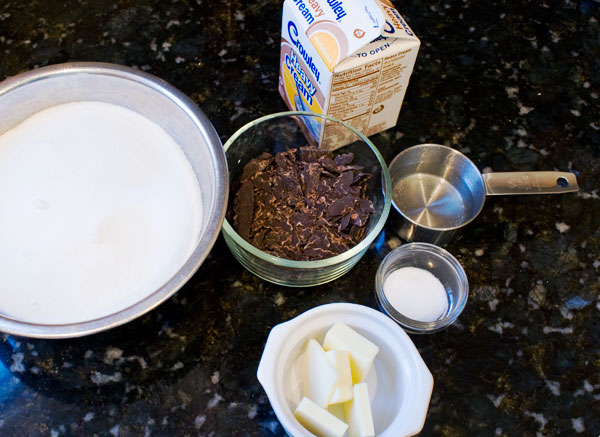
2. Cream, sugar, chopped chocolate and light corn syrup all go into a high-sided sauce pan or pot.
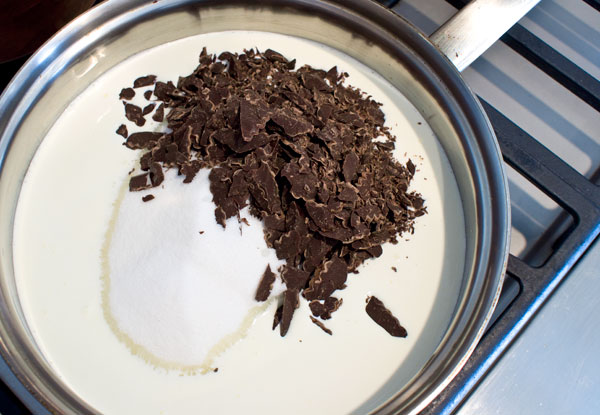
2. Stir ’em up gently over medium heat until completely dissolved, like a bad marriage.
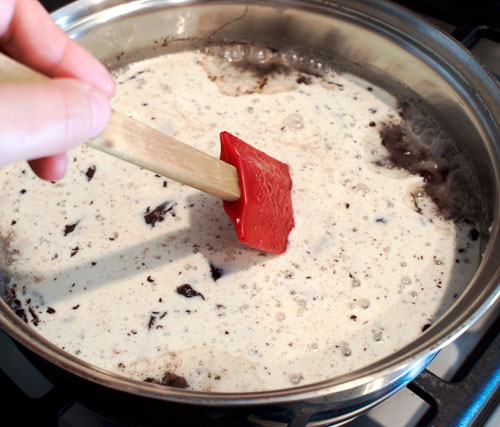
3. Now it’s all liquid and coming to a boil.
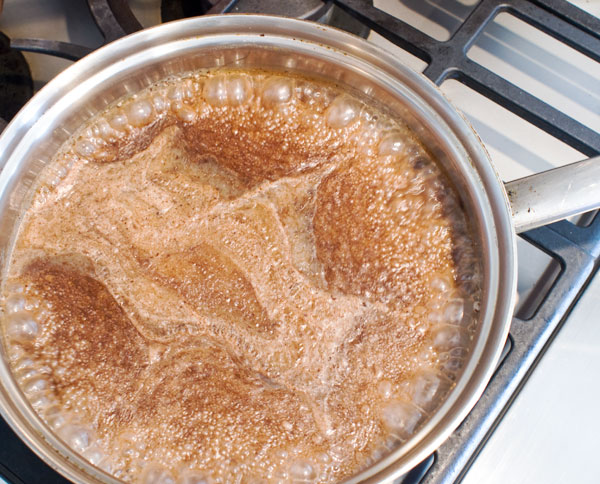
4. Keep the heat on and top the pot off with a lid for a couple of minutes. This will create steam inside which will condense and roll down the sides of the pot and wash away any sugar crystals that may have formed.
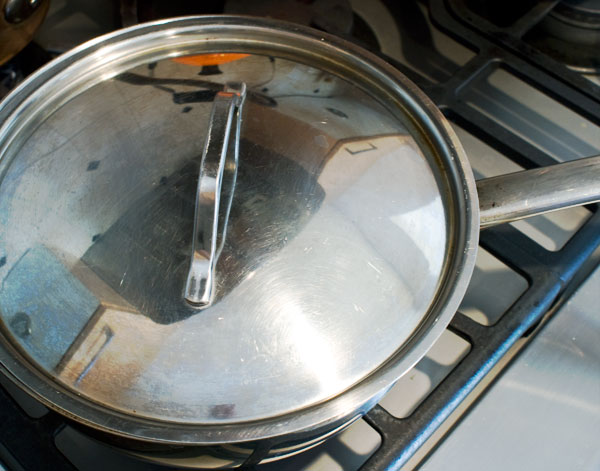
5. Clip a candy thermometer to the side, being careful not to let the mercury bulb touch the bottom (this may give a false reading.) Do not stir any more at this point or face the wrath of unwanted sugar crystal growth. Bring the mix up to 236F-238F degrees. This gets the sugar to what’s called soft ball stage and keeps the fudge at the right consistency once it’s cooled and sliced.
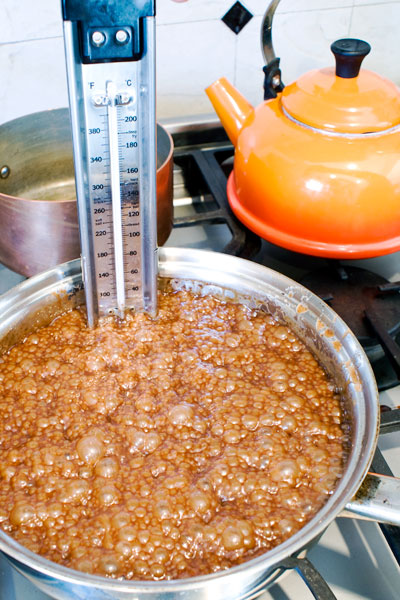
6. While the fudge is coming up to temperature, get your pan ready. Grab an 8″ x 8″ pan and line it with foil.
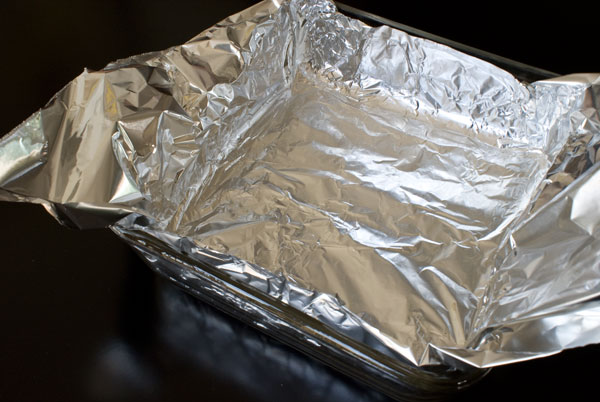
7. You can oil or butter the inside but I’m lazy and simply spritzed it with cooking spray.
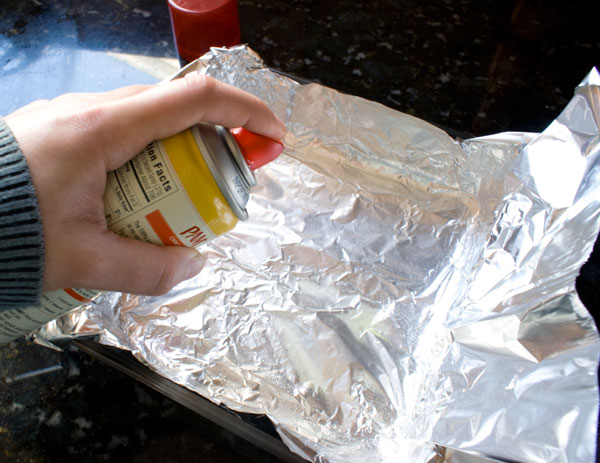
8. Once the fudge comes to the proper temperature, turn off the heat and throw in the butter. Do not stir it in. Again, this may cause unwanted crystals to form. The butter will melt and pool over the top. Let it sit there peacefully until the temperature drops to 110 degrees F (about an hour.)
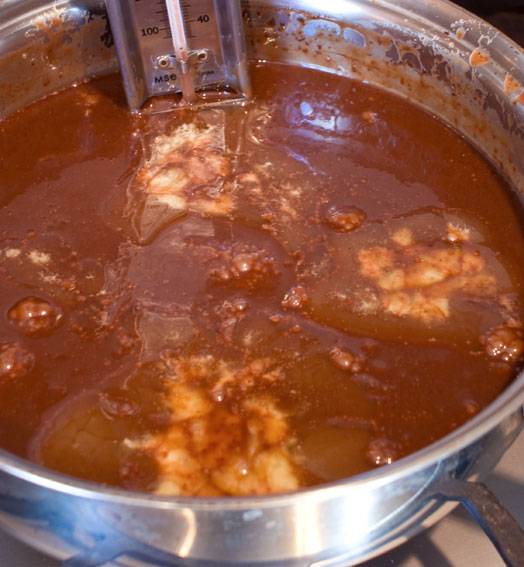
9. Once cooled, start beating on high. At first it will be glossy, but after few minutes of beating, it will become lighter in color and opaque. (If the fudge is too warm when you start beating, the crystals may get too fat. If the mix is too cool, the paddles may start to smoke up from the stiffness. Mine did. If that happens, turn on the heat to low for 30 seconds to re-warm the mix just enough for the batter to get through.)
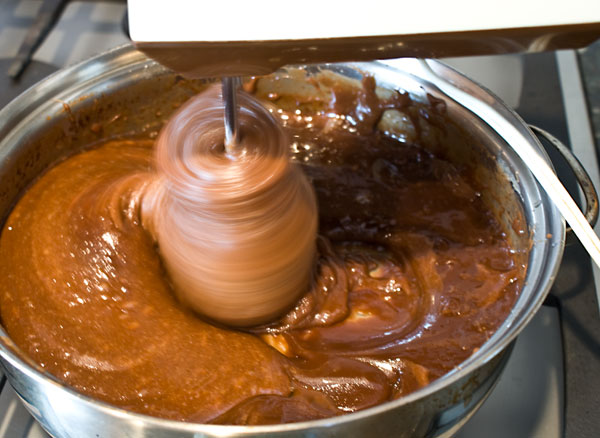
10. Keep beating until the ripples hold their shape, and you can start to see the bottom of the pan through the trails left by the beaters, about 10 minutes. Almost there…
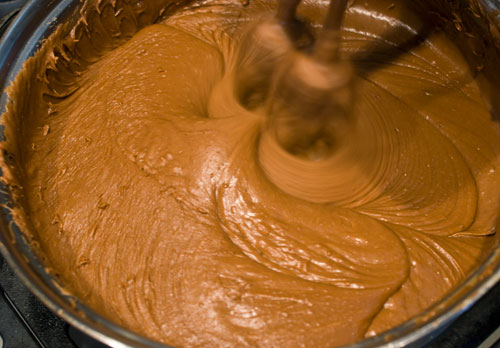
11. Pour into the prepared pan. Now comes the hard part: the waiting. Let this set up completely, at least 2 hours (or over night.)
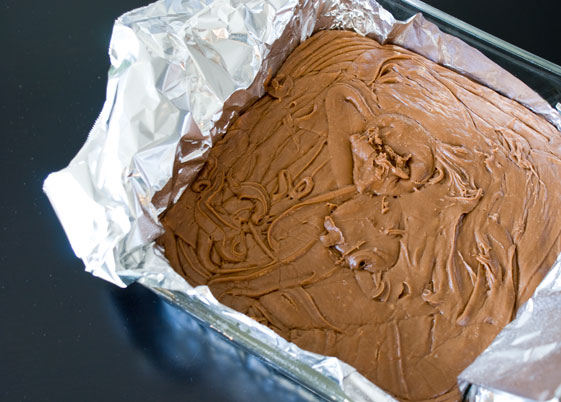
12. Invert on to a cutting board…
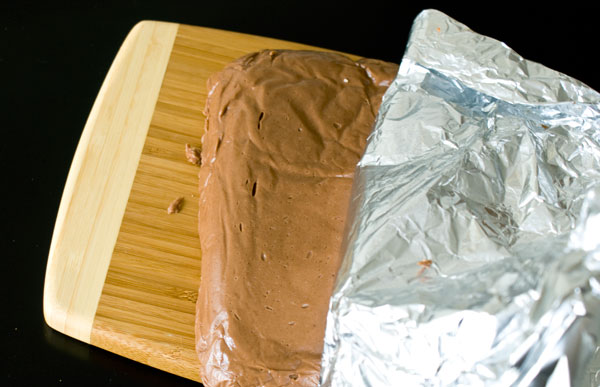
… and cut into squares.
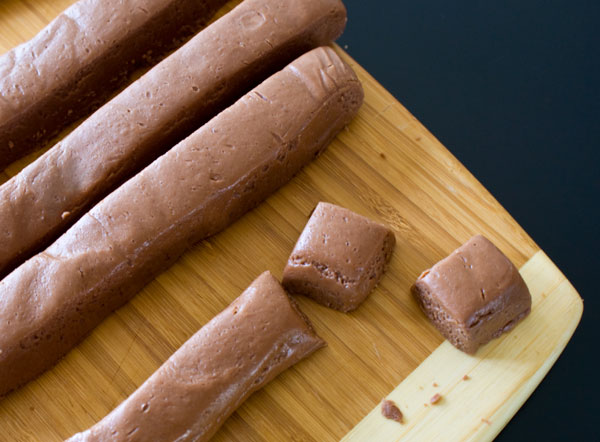
Can’t talk. Eating fudge.
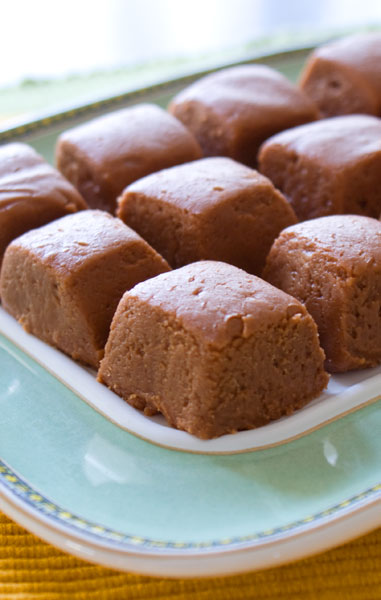
Chocolate Fudge
adapted from Dec 2009/Jan 2010 Fine Cooking magazine
makes twenty-five 1 1/2″ pieces
3 3/4 cups (845 grams) granulated sugar
1 1/2 cups (355 ml) heavy cream
4 ounces (112 grams) unsweetened chocolate, chopped
3 tablespoons (45 ml) light corn syrup
3 tablespoons (42 grams) cold unsalted butter, cut up into cubes
1 tsp (5 grams) salt
1. In a high-sided sauce pan or pot, boil cream, sugar, chopped chocolate and light corn syrup.
2. Stir ‘em up gently over medium heat until completely dissolved.
3. Keep the heat on and top the pot off with a lid for a couple of minutes. This will create steam inside which will condense and roll down the sides of the pot and wash away any sugar crystals that may have formed.
4. Clip a candy thermometer to the side, being careful not to let the mercury bulb touch the bottom (this may give a false reading.) Do not stir any more at this point or face the wrath of unwanted sugar crystal growth. Bring the mix up to 236F-238F degrees. This gets the sugar to what’s called soft ball stage and keeps the fudge at the right consistency once it’s cooled and sliced.
5. While the fudge is coming up to temperature, get your pan ready. Grab an 8″ x 8″ pan and line it with foil. You can oil or butter the inside but I’m lazy and simply spritzed it with cooking spray.
6. Once the fudge comes to the proper temperature, turn off the heat and throw in the butter. Do not stir it in. Again, this may cause unwanted crystals to form. The butter will melt and pool over the top. Let it sit there peacefully until the temperature drops to 110 degrees F (about an hour).
7. Once cooled to 110F, start beating on high. At first it will be glossy, but after few minutes of beating, it will become lighter in color and opaque. (If the fudge is too warm when you start beating, the sugar crystals may get too fat. If the mix is too cool, the paddles may start to smoke up from the batter’s stiffness. Mine did. If that happens, turn on the heat to low for 30 seconds to re-warm the mix just enough for the batter to get through.)
8. Keep beating until the ripples hold their shape, and you can start to see the bottom of the pan through the trails left by the beaters, about 10 minutes.
9. Pour into the prepared pan. Now comes the hard part: the waiting. Let this set up completely, at least 2 hours (or over night.)
10. Invert on to a cutting board, and cut into squares.
Tags: candy, chocolate, confection, dessert, fudge
25 Responses to “Fudging This Post”
Post a Comment
Your E-Mail will be kept private. * = required fields.







It isnt Christmas without fudge! Merry Christmas!
The first photograph is wonderfully executed. The depth of field and bokeh brings out certain features in the first mini-fudge that makes this look catchy.
Neel from Learn Food Photography
THANK YOU!! I’ve been looking for a real fudge recipe (i.e., without the use of marshmallow fluff or condensed milk). I’m also glad you posted your usual, beautiful process photos. I love your blog.
This fudge looks wonderful. I liked reading through all the steps because this is SO different from how I make my mom’s fudge. (I just posted that yesterday.) It seems quite complicated, but the results look perfect.
This is the first time I see the complete process of making fudge… I’d love to try it but here comes the poblem: how can I replace light corn syrup (I hate this thing! you use it all the time!) maybe glucose?
Merry Christmas!
Sil BsAs — There’s something about the chemical make-up of light corn syrup that helps hinder sugar crystal formation. You don’t have to use it though. Go ahead and substitute the glucose, which is similar. Check your glucose, though, because it may be derived from corn, too, and would be essentially the same as corn syrup.
Merry Christmas to you!
Happy hew year to you and to your family!
Thank you for all great recipes you showered on us this year,
i am looking forward to the next year full of exiting baking under your button.
With admiration and love
Batia Gal-on.
Lovely Irina! I want some! Not that I need any more sugar or fat…;P Merry Christmas to you, I hope it’s a good one!
I just wanted to let you know that I nominated you on the Kitchn/Apartment Therapy’s The Homies 2009 blog award: http://homies.apartmenttherapy.com/2009/category/home-cooking
Good luck! 🙂
Memoria — That’s so nice of you! Thank you! We’ll see if I’m any match for some of those big-time blogs out there 🙂 And I hope you try the fudge.
Elizabeth — Thank you. You, of all people, can handle a little sugar and fat now that you’re eating for two. Have a fantastic holiday.
Batia — Thanks, and a happy holiday to you. I’ve got lots of baking planned for this year.
Michelle — Just peeked at your fudge, and though it is a different method, it still looks mighty tempting. I’m all over all things peanut butter.
Neel — Thanks for the vote of confidence. I need all the photography tips I can get.
Jennifer — A very Merry Christmas to you and your family!
The fudge looks amazing, I don’t even like fudge and I still want to make it.
Really love the step by step pictures.
I was wondering though, about corn syrup. What consistancy is it? In the UK we don’t have corn syrup, we have golden syrup and treacle. Golden syrup is the consistancy of runny honey.
Is it the same kind of thing? I can’t seem to find the right information anywhere.
Thank you.
Wow, the fudge looks delicious! I’ve never tried making any fudge as it requires corn syrup and i don’t find it here in Germany. Will surely try it some day 😉
i just love the way u have illustrated the whole process with your photo’s…its really beautiful…and a really nice recipe 🙂 is it necessary for unsweetened chocolate ..can i use normal chocolate
[…] Smooth Chocolate Fudge from Pastry […]
I’ve been wanting to make real fudge, but I was nervous since I had heard it was so difficult. Thanks for the great tutorial. I’m certain it will come in handy when I finally work up the nerve to try it!
BNDQ8 — Not entirely sure what you mean by regular chocolate. Many of the dark chocolates that come in a bar would be ok to use. Some chocolates are quite sweet and could result in a cloying fudge. I like to play around with chocolates myself and see which ones “work” best in recipe, so feel free to experiment with substitutions.
Ramya — You don’t really HAVE to use corn syrup. You can substitute glucose or even regular sugar.
Beks — Golden syrup is a little different from corn syrup. A little research tells me that golden syrup is made by evaporating sugar cane until it thickens and develops a nutty, toasty flavor. I think in this case, it would be a good substitution, so give it a try. (FYI-Corn syrup looks to be similar in thickness and pour-ability, it’s paler in color and does not have much complexity of flavor. It’s just “sweet.”)
I have never made fudge before, but now I’m scared like it’s the same challenge as caramel – with the pesky crystalisation and the whole bit. But for that very reason, I should throw myself into fudge. Right? Conquer my fears??!! Thank you for these (always!) fabulous tips and hints.
I just love your blog. The writing is entertaining, the recipes challenging, and the detailed process photos are such a help. Each one of your posts must take a lot of time to write, but it’s what makes your blog so special.
I was just wondering: is there any reason not to use a stand mixer (as opposed to a hand-held mixer) to beat the fudge?
Astrid — Thank you for reading!
I wondered about that myself and really, I think you probably can use a standing mixer. The only thing I’d be mindful of is the fact that the bowl is cold and might bring down the temperature of the fudge considerably when you make the transfer. So, if I were to use a standing mixer, I’d either warm the bowl a little by popping it in the oven for a minute or I wouldn’t let the fudge cool as much before making the transfer.
I’ll have to give this a try again. The last time I tried making fudge, mine came out grainy and sludgy. Some hanging sugar crystals must have fallen into the mixture during an advanced part of the boiling stage and, as a result, my fudge never set up properly. So, since then, I’ve been a bit apprehensive about doing fudge again. LOL. But I certainly want to get my hands dirty once more and challenge myself to make a great batch and then master it and any other kind of fudge flavor profile I can think of.
I also have always been afraid of doing recipes that require a heavy use of a thermometer because I always wonder if I following the procedure right. If it’s my first time making something, I don’t always know what to look for and expect in each stage of the recipe procedure. I made some poured fondant last year, for cakes, and I didn’t even know if I was making it correctly. Once I did the second batter, I realized I had thrown out a perfectly good pot of poured fondant the first time around. But that’s trial and error for you. Now I know what to expect in texture and look when I am boiling the stuff and then watching it set on top of baked desserts.
Tempering chocolate is something I also want to try one day but it sounds intimidating and tedious, based on what I often hear and read from other cooks.
I’ve always wanted to make fudge. Thanks for the step-by-step. I’m no longer scared. I only need to go buy a candy thermometer!!
[…] came across Irina’s site Pastry Pal and she has a wonderful Chocolate Fudge step-by-step tutorial with photos. Maybe with tips like these, I might gather the courage to […]
in answer to a post, I live in UK, and the fudge recipe I always use, calls for glucose syrup, available at Asda, Tesco, and various other supermarkets. My basic recipe has glucose, granulated sugar, heavy (double) cream, all boiled till soft ball stage. Then when bubbles have gone, I add melted white chocolate with a little butter. It produces a lovely smooth fudge, which can be adapted easily. For vanilla fudge I use white choc, for coffe/walnut, I sometimes use milk choc.
If anyone would like my recipe, please post. Thanks.
ps. love your site.
oh, forgot to add that I used to have a stall at a local farmers market here in Kent, and I used to make and sell my fudge, which went really well with my customers.
Irina, is heavy cream whipping cream? Thanks. The fudge looks amazing. I wonder if this can be done in the microwave. I don’t have a gas burner. I find I burn my cream on an electric element no matter how careful I am. One more query. How would I make a rum and raison fudge? Should I add the rum in the beginning or the end? Thank you.